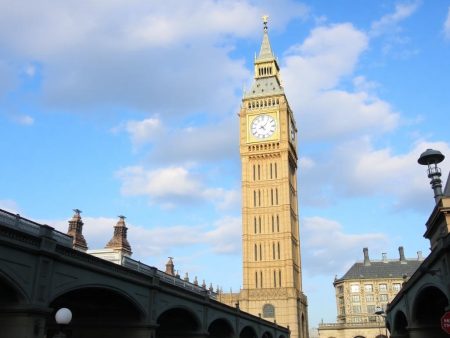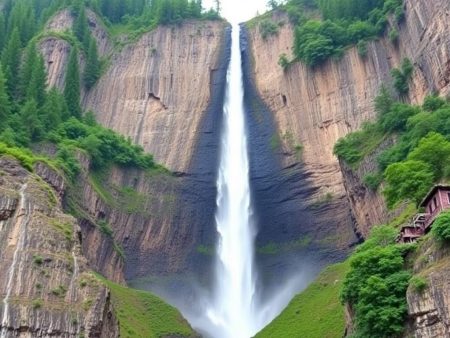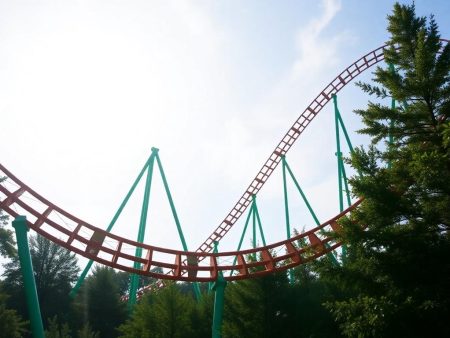Erguendo-se como um símbolo de arte, história e conquistas humanas, a estátua mais alta do mundo é uma maravilha que captura a imaginação. Ao redor do globo, estátuas imponentes foram construídas para honrar líderes, divindades e ideais, mas uma estrutura se eleva acima de todas elas — tanto em altura quanto em significado.
A curiosidade sobre essas criações monumentais muitas vezes desperta a pergunta: qual é a estátua mais alta do mundo?
Qual é a estátua mais alta do mundo? Descubra a magnífica estátua da unidade
Erguendo-se como um símbolo de arte, história e conquistas humanas, a estátua mais alta do mundo é uma maravilha que captura a imaginação. Ao redor do globo, estátuas imponentes foram construídas para honrar líderes, divindades e ideais, mas uma estrutura se eleva acima de todas elas — tanto em altura quanto em significado.
Converta a altura das pessoas, edifícios, montanhas e monumentos mais altos para m, pés e polegadas para comparar
0' 0" é igual a 0,0 cm ou 0,00 m.
A curiosidade sobre essas criações monumentais frequentemente desperta a pergunta: qual é a estátua mais alta do mundo? De suas dimensões de tirar o fôlego à sua importância cultural, esta obra-prima recordista é mais do que apenas um feito de engenharia. É um testamento de visão e ambição que deixa os visitantes maravilhados.
Qual é a estátua mais alta do mundo?
A Estátua da Unidade na Índia é a estátua mais alta do mundo. Medindo 597 pés (182 metros) de altura, essa estrutura enorme supera o Spring Temple Buddha na China, que mede 420 pés (128 metros). Situada no Rio Narmada em Gujarat, a Estátua da Unidade retrata Sardar Vallabhbhai Patel, um líder da independência indiana.
Inaugurada em 31 de outubro de 2018, a estátua atrai milhões de visitantes anualmente. Sua base acrescenta 190 pés (58 metros), tornando a estrutura geral impressionantes 787 pés (240 metros). Projetada pelo artista Ram V. Sutar, ela representa a unidade e a paz na era pós-independência da Índia.
Uma Visão Geral da Estátua da Unidade
A Estátua da Unidade, localizada em Gujarat, Índia, é a estátua mais alta do mundo, com 597 pés (182 metros). Ela se ergue como um símbolo de força e unidade, dedicada a Sardar Vallabhbhai Patel.
Dimensões e Estrutura
A estátua mede 597 pés (182 metros) e atinge uma altura total de 787 pés (240 metros) quando a base de 190 pés (58 metros) é incluída. Seu núcleo de concreto reforçado é cercado por um revestimento de bronze pesando aproximadamente 1.850 toneladas métricas. A resiliência ao vento e sísmica foram considerações importantes em seu design, permitindo que ela resistisse a ventos de até 112 mph (180 km/h) e terremotos medindo até 6,5 na escala Richter.
Localização e acessibilidade
A Estátua da Unidade está situada na Ilha Sadhu Bet no Rio Narmada, perto de Kevadia em Gujarat. É acessível através do Aeroporto Internacional Sardar Vallabhbhai Patel, localizado a cerca de 125 milhas (200 km) de distância. Uma infraestrutura bem desenvolvida, incluindo estradas, ônibus e balsas, garante conectividade perfeita para os visitantes do complexo da estátua.
Significado histórico
A estátua homenageia Sardar Vallabhbhai Patel, o primeiro vice-primeiro-ministro e ministro do Interior da Índia, conhecido por unificar mais de 500 estados principescos na República da Índia pós-independência. Inaugurado em 31 de outubro de 2018, seu 143º aniversário de nascimento, o monumento destaca seu papel fundamental na formação da Índia moderna e se destaca como um tributo à sua dedicação à unidade nacional.
Comparação com outras estátuas altas
A Estátua da Unidade é mais alta do que qualquer outra estátua no mundo. Compará-la com outras estruturas icônicas destaca sua escala e significância extraordinárias.
O Templo da Primavera Buda
O Buda do Templo da Primavera em Henan, China, detinha o título de estátua mais alta antes da Estátua da Unidade. Com 420 pés (128 metros) de altura sem sua base, ele representa o Buda Vairocana, simbolizando sabedoria e paz. Incluindo sua base, a estrutura atinge 682 pés (208 metros) e pesa mais de 1.000 toneladas métricas. Revelado em 2008, ele apresenta um design de fundição de cobre e atrai visitantes de todo o mundo por seu significado espiritual e arquitetônico.
A Estátua da Liberdade
A Estátua da Liberdade na cidade de Nova York, celebrada como um símbolo de liberdade, tem 151 pés (46 metros) sem seu pedestal. Com a base incluída, sua altura chega a 305 pés (93 metros). Dedicada em 1886, a estátua icônica, projetada por Frédéric Auguste Bartholdi, foi um presente da França para os Estados Unidos. Embora sua altura empalideça em comparação com a Estátua da Unidade, seu valor cultural e histórico permanece incomparável.
Outras estátuas altas notáveis
Outras estátuas significativas incluem o Ushiku Daibutsu no Japão, medindo 394 pés (120 metros) sem sua base e concluído em 1993, e o Buda Laykyun Sekkya em Mianmar, com 380 pés (116 metros) de altura e concluído em 2008. Esses monumentos refletem seus respectivos valores culturais, oferecendo exemplos de excelência artística e reverência histórica.
Engenharia e Design Marvel
A Estátua da Unidade exemplifica engenharia avançada e inovação arquitetônica. Seu design combina durabilidade, estética e funcionalidade para criar uma estrutura capaz de suportar forças naturais enquanto inspira admiração.
Materiais usados
Os engenheiros utilizaram um núcleo de concreto reforçado e aço estrutural para fornecer estabilidade e resistência à estátua. Aproximadamente 1.850 toneladas métricas de revestimento de bronze cobrem a superfície externa, adicionando grandeza visual e garantindo durabilidade contra elementos climáticos. Os painéis de bronze, fabricados usando uma mistura de zinco e cobre, foram fundidos na China e encaixados no local com precisão. Essa combinação de materiais garante integridade estrutural e finesse artística.
Processo de construção
A construção, supervisionada por Larson & Toubro, envolveu mais de 3.000 trabalhadores e 250 engenheiros. O processo começou com uma digitalização 3D da imagem de Sardar Vallabhbhai Patel, usada para modelar as características intrincadas da estátua. A montagem da estrutura exigiu planejamento meticuloso, levantando seções pesadas usando guindastes avançados e soldando vastos painéis de bronze na posição. O projeto, concluído em apenas 46 meses, reflete uma mistura perfeita de tecnologia moderna e artesanato tradicional.
Considerações ambientais
O design da estátua prioriza o equilíbrio ecológico e a sustentabilidade. Para lidar com os impactos ambientais, o desenvolvimento incorporou medidas como reflorestamento e preservação de habitat ao redor do Rio Narmada. Uma infraestrutura oca próxima minimiza a interrupção da terra, enquanto o complexo de visitantes inclui sistemas de eficiência energética. Os engenheiros também garantiram que a estrutura pudesse suportar atividade sísmica e ventos fortes, preservando seus arredores e mantendo a segurança.
Turismo e Impacto Econômico
A Estátua da Unidade se tornou uma atração turística global devido ao seu status como a estátua mais alta do mundo. Sua popularidade influencia as experiências dos visitantes e impulsiona significativamente a economia local.
Experiência do visitante
Os visitantes da Estátua da Unidade desfrutam de uma experiência abrangente que combina apreciação cultural e entretenimento. A galeria de observação, localizada a uma altura de 500 pés (152 metros), oferece vistas panorâmicas da Represa Narmada e das cadeias de montanhas Vindhyachal e Satpura ao redor. Um museu e salão de exposições, situados na base da estátua, detalham a vida e as contribuições de Sardar Vallabhbhai Patel, enquanto exibições interativas aumentam a compreensão da história da Índia.
Os turistas podem explorar o Vale das Flores, que apresenta mais de 2,4 milhões de plantas abrangendo várias espécies. Um show de som e luz ilumina a estátua à noite, misturando narrativa com espetáculo visual. Os visitantes também têm acesso a restaurantes, áreas de compras e caminhos bem conservados, garantindo conveniência e conforto durante toda a visita.
Contribuição para a economia local
A Estátua da Unidade gera uma receita substancial para a economia local, atraindo mais de 2,8 milhões de visitantes anualmente. Vendas de ingressos, comodidades recreativas e visitas guiadas contribuem diretamente para o crescimento econômico. Pequenos negócios, incluindo hotéis, vendedores de alimentos e lojas de souvenirs, se beneficiam do aumento do turismo, criando oportunidades de emprego para os moradores.
Projetos de desenvolvimento apoiados pelo governo em torno da estátua, como transporte e infraestrutura melhorados, transformaram a região em um próspero centro turístico. Os gastos anuais com turistas aumentam significativamente a receita do estado, promovendo benefícios econômicos de longo prazo para Gujarat.
Conclusão
A Estátua da Unidade se destaca como uma fusão notável de arte, engenharia e significado cultural. Além de sua presença imponente, ela representa uma mensagem poderosa de unidade e progresso que ressoa globalmente. Este monumento inspirador não apenas homenageia o legado de Sardar Vallabhbhai Patel, mas também mostra a dedicação da Índia à inovação e à herança. Visitantes do mundo todo continuam a ser cativados por sua grandeza, tornando-a um símbolo de orgulho e inspiração para as gerações futuras.
Perguntas frequentes
O que é a Estátua da Unidade e onde ela está localizada?
A Estátua da Unidade é a estátua mais alta do mundo, com 597 pés (182 metros). Ela homenageia Sardar Vallabhbhai Patel, um líder da independência indiana. Localizada na Ilha Sadhu Bet no Rio Narmada, Gujarat, Índia, a estátua é um símbolo de unidade e conquista indiana moderna.
Qual é a altura da Estátua da Unidade em comparação com outras estátuas?
A Estátua da Unidade tem 182 metros de altura, superando o Buda do Templo da Primavera na China (127 metros) e a Estátua da Liberdade em Nova York (93 metros com seu pedestal).
Quem foi Sardar Vallabhbhai Patel?
Sardar Vallabhbhai Patel foi um proeminente líder da independência indiana que desempenhou um papel vital na união de mais de 500 estados principescos na República da Índia. A estátua é um tributo à sua dedicação à unidade nacional.
O que torna a Estátua da Unidade uma maravilha da engenharia?
A estátua apresenta um núcleo de concreto reforçado com revestimento de bronze, pesando 1.850 toneladas métricas. Foi projetada para suportar terremotos de até 6,5 na escala Richter e ventos fortes de 112 mph (180 km/h).
Quais instalações estão disponíveis para os visitantes na Estátua da Unidade?
Os visitantes podem aproveitar uma galeria de observação a 500 pés, um museu sobre a vida de Patel, exibições interativas sobre a história indiana e o Vale das Flores. Há também um show de som e luz à noite.
Como a Estátua da Unidade impacta o turismo e a economia local?
A estátua atrai mais de 2,8 milhões de visitantes anualmente, impulsionando a economia local por meio de vendas de ingressos, negócios relacionados ao turismo e criação de empregos. Projetos de desenvolvimento também melhoraram a infraestrutura da região.
Como os visitantes podem chegar à Estátua da Unidade?
A Estátua da Unidade é acessível pelo Aeroporto Internacional Sardar Vallabhbhai Patel, localizado a aproximadamente 200 km de distância, com estradas bem desenvolvidas, ônibus e balsas garantindo conectividade tranquila.
Quais são as medidas ambientais tomadas durante a construção?
Esforços foram feitos para preservar o habitat ao redor do Rio Narmada, incluindo reflorestamento e medidas de equilíbrio ecológico, garantindo a sustentabilidade junto com a construção da estátua.
Quanto tempo levou para construir a Estátua da Unidade?
A construção da Estátua da Unidade, supervisionada por Larson & Toubro, foi concluída em apenas 46 meses, combinando tecnologia moderna e artesanato tradicional.
Por que a Estátua da Unidade é culturalmente significativa?
A estátua simboliza unidade e paz enquanto honra a contribuição de Patel para moldar a Índia moderna. Ela representa a herança indiana, a ambição e os triunfos da independência.





